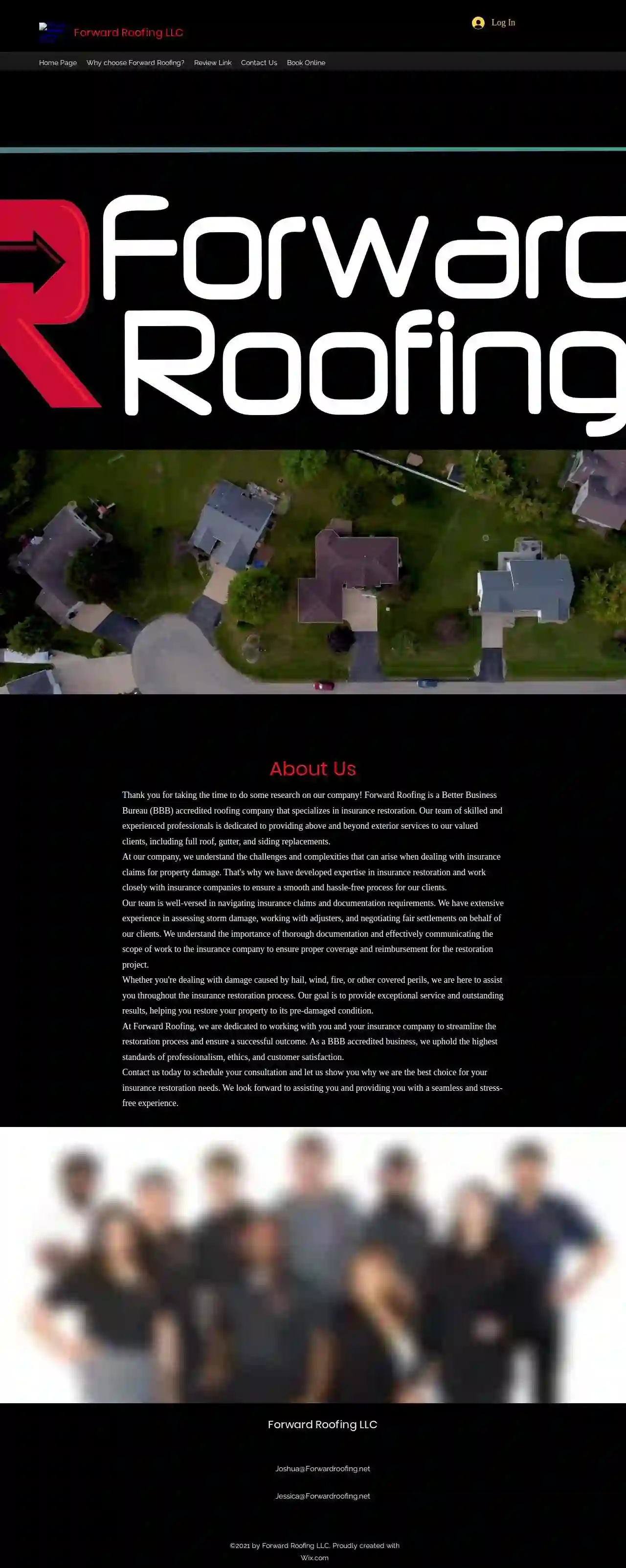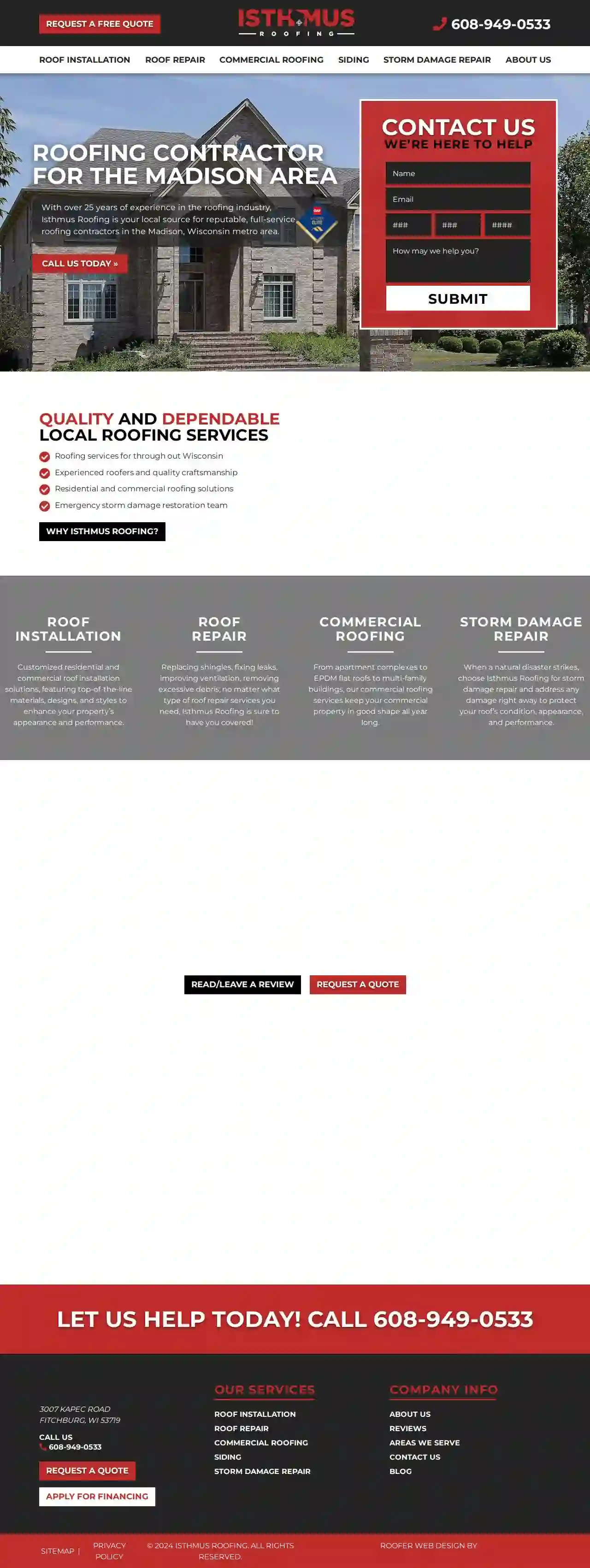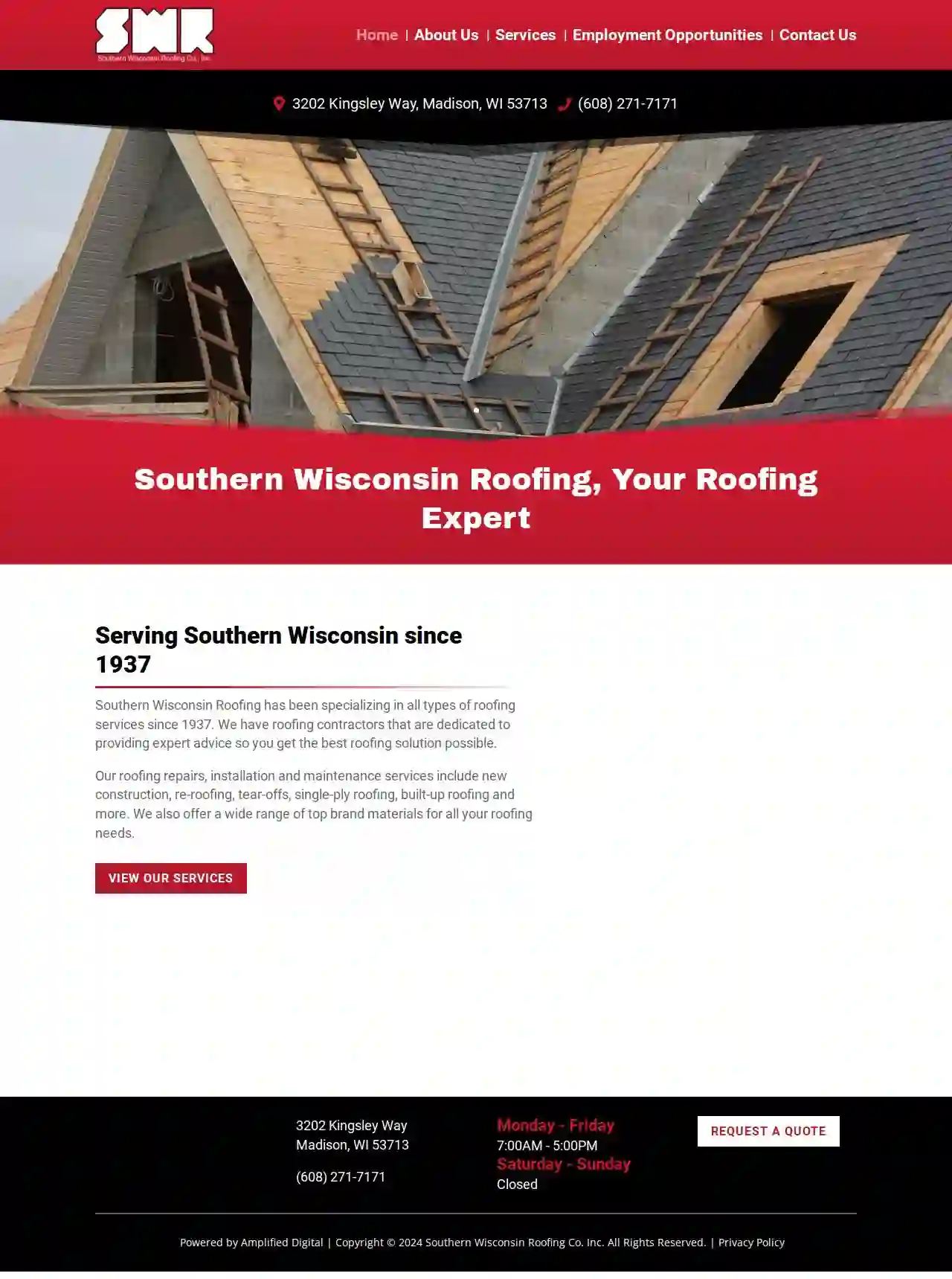Roofing Companies Oshkosh
Best Roofing Company in Oshkosh
Get multiple Roofing Contractor quotes for your project today! Compare profiles, reviews, accreditations, portfolio, etc... and choose the best service.

A-Tech Roofing System
4.516 reviewsKenosha, 53140, USSuperior Residential and Commercial Roofing Solutions in Racine and Kenosha Counties Free Estimates | 15-Year Leak-Free Guarantee on Full Roof Replacement | Competitive Pricing Finding a skilled and efficient roofing contractor can be a daunting task. Homeowners and businesses alike often struggle to identify a reliable roofing service provider who can deliver quality workmanship and exceptional service. Trust A-Tech Roofing System to handle all your roofing-related work and more. As a local, veteran, and family-owned business, we have been proudly serving the Kenosha, WI, community for over 30 years. We are also a Mule-Hide certified. Our commitment to excellence and customer satisfaction sets us apart from the competition. Call (262) 484-8464 to schedule your appointment now in Racine and Kenosha counties.
- Services
- Why Us?
- Accreditations
- Our Team
- Testimonials
- Gallery
Get Quote
Weather Tight Corporation
4.7769 reviews123 Main St, Milwaukee, 12345, USWeather Tight Corp is a leading provider of home improvement services, offering a wide range of products and solutions for windows, doors, siding, roofing, and more. With a commitment to quality and customer satisfaction, we strive to deliver exceptional results and exceed our customers' expectations. Our team of experts is dedicated to providing personalized service and ensuring that every project is completed to the highest standards. Whether you're looking to upgrade your home's exterior, improve its energy efficiency, or simply enhance its curb appeal, we have the expertise and resources to help you achieve your goals. Contact us today to learn more about our services and how we can help you achieve your home improvement dreams.
- Services
- Why Us?
- Accreditations
- Gallery
Get Quote
Forward Roofing
4.724 reviews747 E. Philhower Rd., USForward Roofing is a Better Business Bureau (BBB) accredited roofing company that specializes in insurance restoration. Our team of skilled and experienced professionals is dedicated to providing above and beyond exterior services to our valued clients, including full roof, gutter, and siding replacements. At our company, we understand the challenges and complexities that can arise when dealing with insurance claims for property damage. That's why we have developed expertise in insurance restoration and work closely with insurance companies to ensure a smooth and hassle-free process for our clients. Our team is well-versed in navigating insurance claims and documentation requirements. We have extensive experience in assessing storm damage, working with adjusters, and negotiating fair settlements on behalf of our clients. We understand the importance of thorough documentation and effectively communicating the scope of work to the insurance company to ensure proper coverage and reimbursement for the restoration project. Whether you're dealing with damage caused by hail, wind, fire, or other covered perils, we are here to assist you throughout the insurance restoration process. Our goal is to provide exceptional service and outstanding results, helping you restore your property to its pre-damaged condition. At Forward Roofing, we are dedicated to working with you and your insurance company to streamline the restoration process and ensure a successful outcome. As a BBB accredited business, we uphold the highest standards of professionalism, ethics, and customer satisfaction. Contact us today to schedule your consultation and let us show you why we are the best choice for your insurance restoration needs. We look forward to assisting you and providing you with a seamless and stress-free experience.
- Services
- Why Us?
- Accreditations
- Our Team
- Testimonials
- Gallery
Get Quote
Isthmus Roofing
585 reviews3007 Kapec Road, Fitchburg, 53719, USWith over 25 years of experience in the roofing industry, Isthmus Roofing has been proud to provide the Madison, Wisconsin area with reputable, professional roofing contractor services. We’ve spent decades building up our reputation as a locally owned and operated enterprise, committed to offering our Wisconsin residential clients the utmost customer service possible. When you need fast, efficient, and accommodating roofing and home exterior maintenance assistance, contact Isthmus Roofing today! To put it simply, roofing repair and installation is what we do. We take pride in seeing our finished work throughout the state of Wisconsin . Once our job is done, we don’t consider our clients to be customers anymore; from now on, they’re neighbors.From proficient roof repair and installation services to commercial roofing projects and siding to storm damage repair, our team of certified and experienced roofing specialists will keep you informed every step of the way throughout our exterior maintenance process, so you can rest assured that your property is in good hands. While our hard work and dedication have helped us continue doing what we love doing, it’s our loyal customers that keep us coming back for more.
- Services
- Why Us?
- Testimonials
- Gallery
Get Quote
Pro Valley Roofing
4.916 reviewsAppleton, WI, 1280 South Van Dyke Rd, Unit 2, 54914, USWelcome to Pro Valley Roofing, your trusted Appleton, Wisconsin roofing contractor for beautiful and dependable new roofs, siding, and gutter systems! Transforming homes with exceptional craftsmanship and a commitment to exceeding customer expectations. We treat every home we work on as if it were our own, and every customer like family. We specialize in elevating your Appleton home's exterior with: New Roof Installation: It's time for a brand new roof! Our GAF-certified roofers are among the elite in America, ensuring top-quality installations with extended warranties. We offer a variety of GAF roofing options to complement your home's style and protect your investment for years to come. Explore our Roof Replacement Options to find the perfect fit for your needs and budget. Siding Installation: Upgrade your curb appeal and energy efficiency with beautiful new siding. We offer a wide range of styles and materials, from classic vinyl to modern steel, all expertly installed by our skilled siding crews. Discover the difference new siding can make Siding Options. Seamless Gutter Installation: A properly functioning gutter system is vital. We provide seamless gutter installation for optimal water flow and a sleek look. Learn more about our expert Gutter Installation Services. Soffit & Fascia Wrap: Complete your home's exterior transformation with soffit and fascia wrapping. We offer durable and attractive materials to enhance your curb appeal and provide added protection. See the finishing touches our Soffit & Fascia Wrap can add. Why Choose Pro Valley Roofing for Your Appleton Home Exterior Project? GAF-Certified Roofers: Our team is among the top 4% of GAF-certified roofers in the nation, guaranteeing the highest quality work and extended warranties for your peace of mind. Wide Range of Services: We provide new roof installation, siding installation, seamless gutter installation, and soffit & fascia wrap, all under one roof (quite literally!). Quality Materials & Expertise: We use only the best materials from trusted brands like GAF, and our experienced crews ensure flawless installation. Competitive Prices & Free Estimates: Get a free consultation and estimate for your project with no obligation. Exceptional Customer Service: We prioritize clear communication and keep you informed throughout the entire project. We Treat You Like Family: At Pro Valley Roofing, we understand the importance of your home. That's why we treat every project as if it were our own, and every customer with the respect and care they deserve.
- Services
- Why Us?
- Testimonials
- Gallery
Get Quote
All Seasons Roofing Contractors Appleton Wi
52 reviewsAppleton, USAt All Seasons Roofing Contractors Appleton Wi, you'll find a family-run and owned business in Appleton with years of experience. Rest assured, we are the roofing contractors – all the work is carried out by us, not sub-contractors, so you know the quality is going to be high. With very low overheads we know we can offer competitive prices. We pride ourselves on delivering projects on time and to budget. From minor repairs to a completely new roof, our skilled team can advise on the different options to fit your taste and budget, and they have the experience to provide solutions for residential and commercial properties. Why Choose Us? Free consultation Expert Services Competitive Prices On Time and On Budget
- Services
- Why Us?
- Testimonials
Get Quote
Southern Wi Roofing Co Inc
55 reviews3202 Kingsley Way, Madison, 53713, USSouthern Wisconsin Roofing has been specializing in all types of roofing services since 1937. We have roofing contractors that are dedicated to providing expert advice so you get the best roofing solution possible. Our roofing repairs, installation and maintenance services include new construction, re-roofing, tear-offs, single-ply roofing, built-up roofing and more. We also offer a wide range. of top brand materials for all your roofing needs. Southern Wisconsin Roofing is licensed, fully insured and bonded by the state. Every case given to us receives specialized complimentary consultations from our trained roofing contractors.
- Services
- Why Us?
- Gallery
Get Quote
Dialed In Roofing & Exteriors
54 reviews5139 N 124th St, Butler, 53007-1322, USWith over a quarter-century of expertise, Dialed In Roofing & Exteriors stands as a beacon of trust and quality in the roofing industry. Serving a diverse clientele across the greater southeastern Wisconsin area, we pride ourselves on delivering roofing solutions that are not just robust and beautiful, but also tailored to meet the unique needs of each customer.
- Services
- Why Us?
- Accreditations
- Our Team
- Testimonials
- Gallery
Get Quote
Infinity Exteriors
4.797 reviewsLittle Chute, 3090 Spirit Ct #3, Appleton, 54913, USInfinity Exteriors is Wisconsin's largest exterior remodeling and roofing company, serving over 20,000 customers across the state. With a focus on education and transparency, Infinity Exteriors empowers homeowners to make informed decisions about their exterior projects. They offer a wide range of services, including roofing, siding, windows, gutters, and attic insulation, using high-quality materials from top national brands like Owens Corning, James Hardie, and ProVia. Infinity Exteriors is committed to providing exceptional customer service and a lifetime workmanship warranty on all their projects. They have won more awards from manufacturers, suppliers, and consumers than any other roofing company in Wisconsin, and their team of highly-trained professionals is dedicated to delivering quality workmanship and lasting results.
- Services
- Why Us?
- Accreditations
- Our Team
- Testimonials
- Gallery
Get Quote
Great Lakes Roofing Corporation
4.735 reviewsW194 N11095 Kleinmann Drive, Germantown, 53022, USOur mission is to be our clients’ trusted partner and first choice for roofing solutions. To achieve our mission, we are guided by 4 Pillars: Safety, Customer Service, Quality, and Employee Experience. Founded in 1983, GLRC is still family-owned and operated. We’ve been creating roofing solutions across the Midwest for nearly 40 years, and we’re not slowing down now. From local branches, we service all of Wisconsin, Michigan’s Upper Peninsula, Iowa, Minnesota, and northern Illinois. Our experience ranges far and wide across many building types from food processing facilities to machine shops, commercial storefronts, and apartment/condo buildings. We’ve also covered schools, houses of worship, and warehouses. No roof is too steep, no leak is too elusive for the roofing professionals at Great Lakes Roofing Corp.
- Services
- Why Us?
- Gallery
Get Quote
Over 17,196+ Roofers onboarded
Our roofing experts operate in Oshkosh & beyond!
Roofyng.com has curated and vetted the Best Roofing Businesses near Oshkosh. Find a top & trustworthy contractor today.
Frequently Asked Questions About Roofing Companies
- Experience: 'How long have you been in business, and what experience do you have with similar projects?'
- Licensing and insurance: 'Are you licensed and insured, and can I see proof of coverage?'
- Warranties: 'What warranties do you offer on your work and the materials used?'
- References: 'Can you provide references from past clients?'
- Project Timeline: 'What is the estimated timeline for completing the project?'
- Payment Terms: 'What are your payment terms, and do you require a deposit?'
- Communication: 'How will you keep me updated on the project's progress?'
- Cleanup: 'What steps will you take to protect my property during the project and ensure proper cleanup afterward?'
- Style: Consider your home's architectural style and choose a roofing material that complements it.
- Climate: Factor in your local climate conditions. Some materials perform better in extreme heat, cold, or high winds than others.
- Budget: Roofing materials have a wide range of costs. Determine your budget and choose materials that fit your financial constraints.
- Durability and Lifespan: Assess the expected lifespan and durability of different materials.
- Energy Efficiency: Choose materials with good insulation and reflectivity properties to improve your home's energy efficiency.
What questions should I ask a roofing contractor?
What is the difference between a roofer and a general contractor?
Roofer: Specializes in roof installations, repairs, and replacements. They have expertise in roofing materials, techniques, and safety practices specific to roofing.
General Contractor: Oversees and manages entire construction projects, including hiring and coordinating subcontractors, such as roofers, electricians, plumbers, etc. They handle overall project planning, scheduling, and budgeting.
For roofing projects, it's generally best to hire a roofing contractor who specializes in roof work.
How do I choose the right roofing materials for my home?
What is fascia, and why is it important?
What questions should I ask a roofing contractor?
- Experience: 'How long have you been in business, and what experience do you have with my type of roof?'
- Licensing and insurance: 'Are you licensed and insured, and can I see proof of coverage?'
- Warranties: 'What warranties do you offer on your work and the materials used?'
- References: 'Can you provide references from past clients?'
- Project Timeline: 'What is the estimated timeline for completing the project?'
- Payment Terms: 'What are your payment terms, and do you require a deposit?'
- Communication: 'How will you keep me updated on the project's progress?'
- Cleanup: 'What steps will you take to protect my property during the project and ensure proper cleanup afterward?'
What is the difference between a roofer and a general contractor?
Roofer: Specializes in roof installations, repairs, and replacements. They have expertise in roofing materials, techniques, and safety practices specific to roofing.
General Contractor: Oversees and manages entire construction projects, including hiring and coordinating subcontractors, such as roofers, electricians, plumbers, etc. They handle overall project planning, scheduling, and budgeting.
For roofing projects, it's generally best to hire a roofing contractor who specializes in roof work.
How do I choose the right roofing materials for my home?
- Style: Consider your home's architectural style and choose a roofing material that complements it.
- Climate: Factor in your local climate conditions. Some materials perform better in extreme heat, cold, or high winds than others.
- Budget: Roofing materials have a wide range of costs. Determine your budget and choose materials that fit your financial constraints.
- Durability and Lifespan: Assess the expected lifespan and durability of different materials.
- Energy Efficiency: Choose materials with good insulation and reflectivity properties to improve your home's energy efficiency.